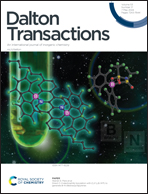Recycling primary lithium batteries using a coordination chemistry approach: recovery of lithium and manganese residues in the form of industrially important materials†
Abstract
In this study, we have investigated the potential use of post-consumer primary lithium metal batteries (LMBs) commonly used in portable electronic devices to recover lithium and manganese in the form of industrially important materials. A direct reaction of lithium-containing electronic waste with a naturally sourced ester, methyl salicylate, combined with a wide range of aliphatic alcohols has been used as a general method for recovering lithium in the form of lithium aryloxides of different nuclearities [Li(OAr)(HOMe)2] (1), [Li(OAr)(HOAr)] (2), [Li(OAr)(HOEt)]2 (3), [Li(OAr)(H2O)]2 (4), [Li4(OAr)4(EGME)2] (5), [Li6(OAr)6] (6–8) for ArOH = methyl salicylate (1, 2, 4, 6), ethyl salicylate (3, 7), 2-methoxyethyl salicylate (5, 8), and EGME = 2-methoxyethanol. The hydrolysis of 7 was then used to synthesize lithium salicylate [Li(Sal)(H2O)]n (10), which is an important antioxidant in the production of oils and grease. The discharged cathode material of Li–MnO2 batteries was investigated as a source from which LiClO4, Li2CO3, LiMn2O4, and Mn2O3 can be recovered by means of water–alcohol extraction or calcination. Particular emphasis was placed on the detailed characterization of all battery components and their decomposition products. LMBs were completely recycled for the first time, and materials were recovered from the cathode and the anode.



 Please wait while we load your content...
Please wait while we load your content...